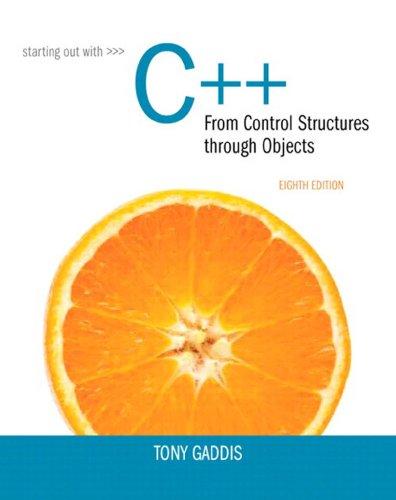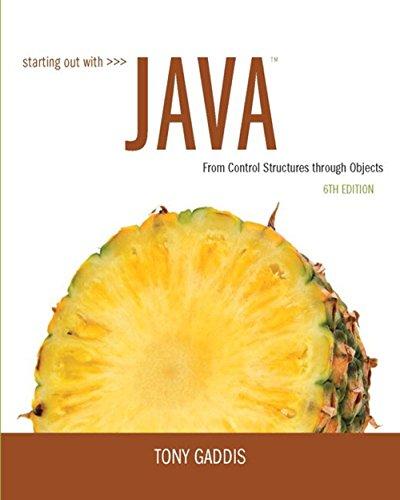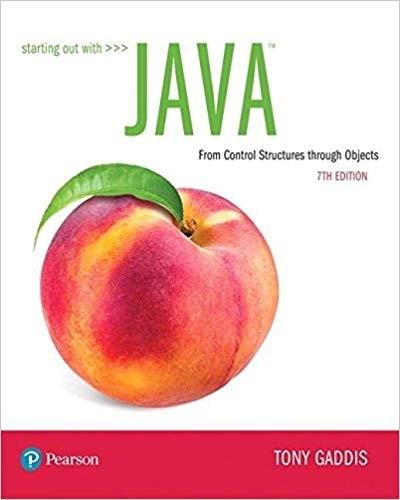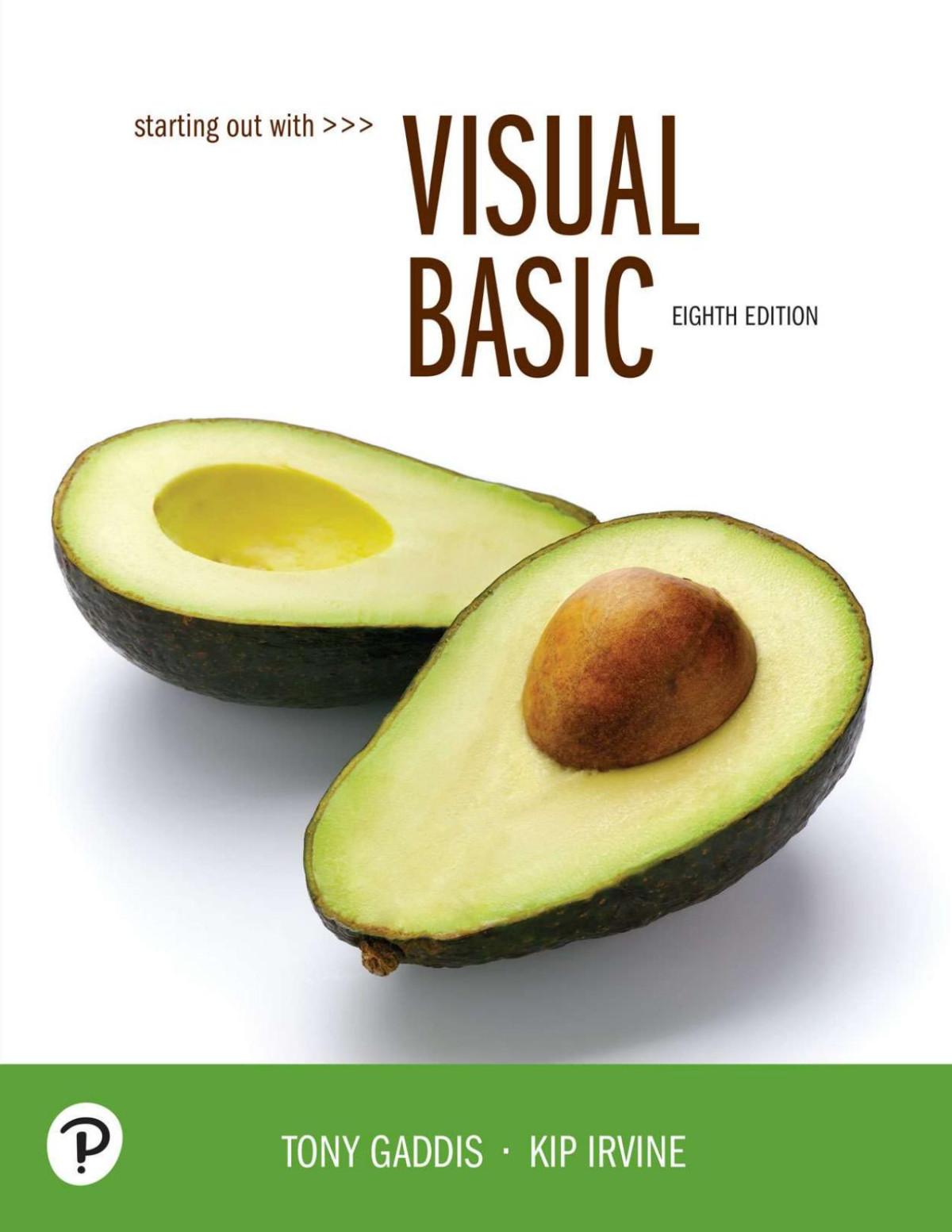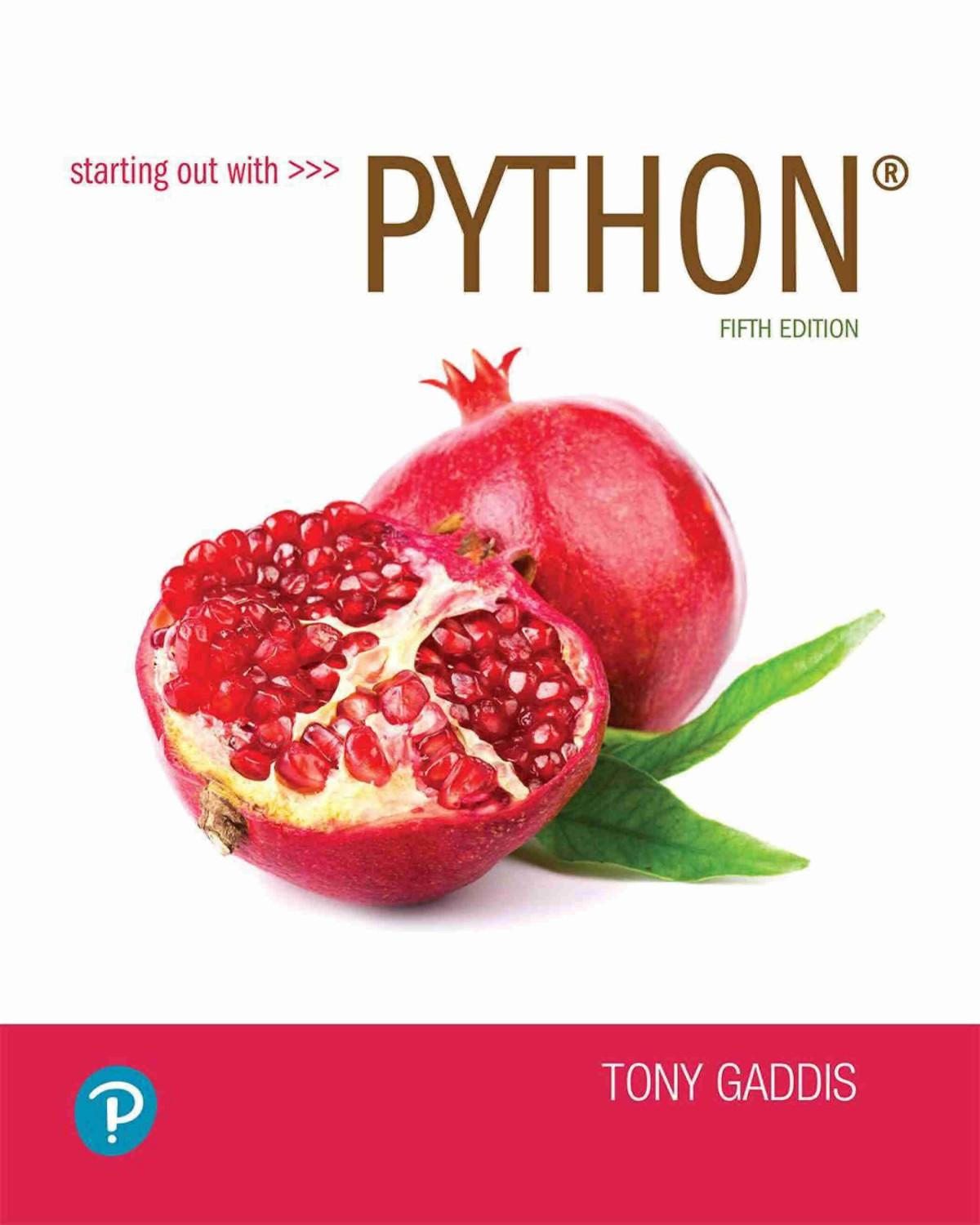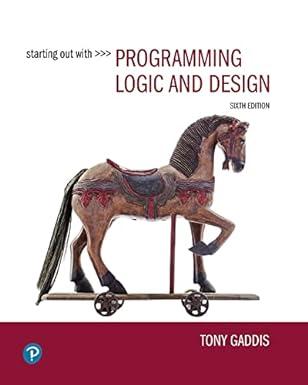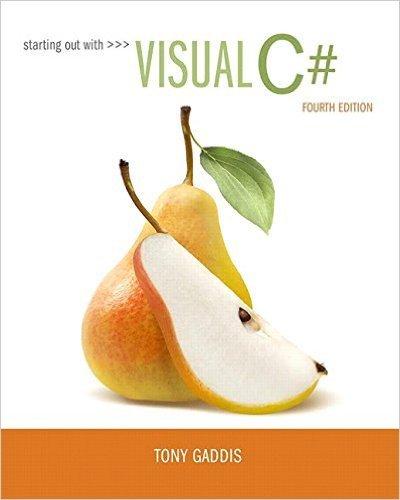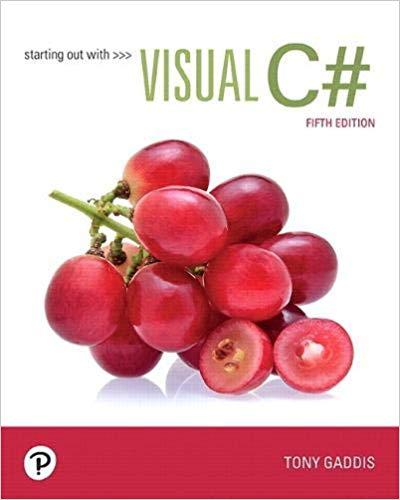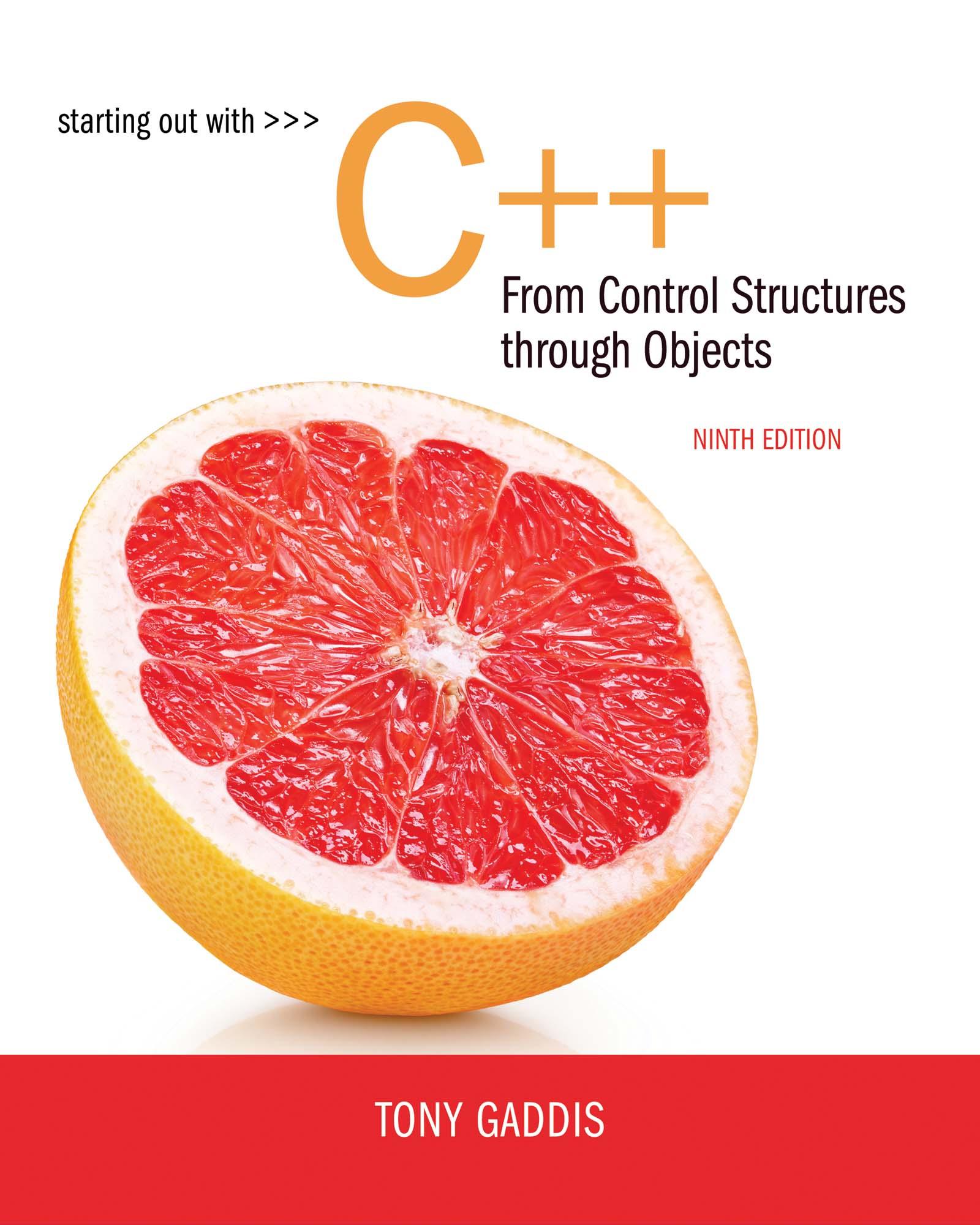Starting Out with C++ From Control Structures Through Objects
Ninth Edition
Haywood Community College
330 Hudson Street, New York, NY 10013
Tony Gaddis
Senior Vice President Courseware Portfolio Management: Marcia J. Horton
Director, Portfolio Management: Engineering, Computer Science & Global Editions: Julian Partridge
Portfolio Manager: Matt Goldstein
Portfolio Management Assistant: Kristy Alaura
Field Marketing Manager: Demetrius Hall
Product Marketing Manager: Yvonne Vannatta
Managing Producer, ECS and Math: Scott Disanno
Content Producer: Sandra L. Rodriguez
Composition: iEnergizer Aptara , Ltd.
Cover Designer: Joyce Wells
Cover Photo: Samokhin/123RF
Credits and acknowledgments borrowed from other sources and reproduced, with permission, appear on the Credits page in the endmatter of this textbook.
Copyright © 2018, 2015, 2012, 2009 Pearson Education, Inc. Hoboken, NJ 07030. All rights reserved. Manufactured in the United States of America. This publication is protected by copyright and permissions should be obtained from the publisher prior to any prohibited reproduction, storage in a retrieval system, or transmission in any form or by any means, electronic, mechanical, photocopying, recording, or otherwise. For information regarding permissions, request forms and the appropriate contacts within the Pearson Education Global Rights & Permissions department, please visit www.pearsoned.com/permissions/.
Many of the designations by manufacturers and seller to distinguish their products are claimed as trademarks. Where those designations appear in this book, and the publisher was aware of a trademark claim, the designations have been printed in initial caps or all caps.
The author and publisher of this book have used their best efforts in preparing this book. These efforts include the development, research, and testing of theories and programs to determine their effectiveness. The author and publisher make no warranty of any kind, expressed or implied, with regard to these programs or the documentation contained in this book. The author and publisher shall not be liable in any event for incidental or consequential damages with, or arising out of, the furnishing, performance, or use of these programs.
Pearson Education Ltd., London
Pearson Education Singapore, Pte. Ltd
Pearson Education Canada, Inc.
Pearson Education Japan
Pearson Education Australia PTY, Ltd
Pearson Education North Asia, Ltd., Hong Kong
Pearson Education de Mexico, S.A. de C.V.
Pearson Education Malaysia, Pte. Ltd.
Pearson Education, Inc., Hoboken
Library of Congress Cataloging-in-Publication Data
Names: Gaddis, Tony, author.
Title: Starting out with C++. From control structures through objects / Tony Gaddis, Haywood Community College.
Other titles: From control structures through objects | Starting out with C plus plus. From control structures through objects
Description: Ninth edition. | Boston : Pearson Education, Inc., [2017]
Identifiers: LCCN 2016056456 | ISBN 9780134498379 (alk. paper) |
ISBN 0134498372 (alk. paper)
Subjects: LCSH: C++ (Computer program language)
Classification: LCC QA76.73.C153 G334 2017 | DDC 005.13/3—
dc23 LC record available at https://lccn.loc.gov/2016056456
1 17
ISBN-13: 978-0-13-449837-9
ISBN-10: 0-13-449837-2
Contents at a Glance
Preface xvii
Chapter 1 Introduction to Computers and Programming 1
Chapter 2 Introduction to C++ 27
Chapter 3 Expressions and Interactivity 85
Chapter 4 Making Decisions 151
Chapter 5 Loops and Files 231
Chapter 6 Functions 305
Chapter 7 Arrays and Vectors 381
Chapter 8 Searching and Sorting Arrays 463
Chapter 9 Pointers 503
Chapter 10 Characters, C-Strings, and More about the string
Class 557
Chapter 11 Structured Data 613
Chapter 12 Advanced File Operations 665
Chapter 13 Introduction to Classes 719
Chapter 14 More about Classes 817
Chapter 15 Inheritance, Polymorphism, and Virtual Functions 907
Chapter 16 Exceptions and Templates 989
Chapter 17 The Standard Template Library 1029
Chapter 18 Linked Lists 1123
Chapter 19 Stacks and Queues 1165
Chapter 20 Recursion 1223
Chapter 21 Binary Trees 1257
Appendix A: The ASCII Character Set 1287
Appendix B: Operator Precedence and Associativity 1289
Quick References 1291
Index 1293
Credit 1311
Online The following appendices are available at www.pearsonhighered.com/gaddis.
Appendix C: Introduction to Flowcharting
Appendix D: Using UML in Class Design
Appendix E: Namespaces
Appendix F: Passing Command Line Arguments
Appendix G: Binary Numbers and Bitwise Operations
Appendix H: STL Algorithms
Appendix I: Multi-Source File Programs
Appendix J: Stream Member Functions for Formatting
Appendix K: Unions
Appendix L: Answers to Checkpoints
Appendix M: Answers to Odd Numbered Review Questions
Case Study 1: String Manipulation
Case Study 2: High Adventure Travel Agency—Part 1
Case Study 3: Loan Amortization
Case Study 4: Creating a String Class
Case Study 5: High Adventure Travel Agency—Part 2
Case Study 6: High Adventure Travel Agency—Part 3
Case Study 7: Intersection of Sets
Case Study 8: Sales Commission
Preface xxiii
Chapter 1 Introduction to Computers and Programming 1
1.1 Why Program? 1
1.2 Computer Systems: Hardware and Software 2
1.3 Programs and Programming Languages 8
1.4 What Is a Program Made of? 14
1.5 Input, Processing, and Output 17
1.6 The Programming Process 18
1.7 Procedural and Object-Oriented Programming 22
Review Questions and Exercises 24
Chapter 2 Introduction to C++ 27
2.1 The Parts of a C++ Program 27
2.2 The cout Object 31
2.3 The #include Directive 36
2.4 Variables, Literals, and Assignment Statements 38
2.5 Identifiers 42
2.6 Integer Data Types 43
2.7 The char Data Type 49
2.8 The C++ string Class 53
2.9 Floating-Point Data Types 55
2.10 The bool Data Type 58
2.11 Determining the Size of a Data Type 59
2.12 More about Variable Assignments and Initialization 60
2.13 Scope 62
2.14 Arithmetic Operators 63
2.15 Comments 71
2.16 Named Constants 73
2.17 Programming Style 75
Review Questions and Exercises 77
Programming Challenges 81
Chapter 3 Expressions and Interactivity 85
3.1 The cin Object 85
3.2 Mathematical Expressions 91
3.3 When You Mix Apples and Oranges: Type Conversion 100
3.4 Overflow and Underflow 102
3.5 Type Casting 103
3.6 Multiple Assignment and Combined Assignment 106
3.7 Formatting Output 110
3.8 Working with Characters and string Objects 120
3.9 More Mathematical Library Functions 126
3.10 Focus on Debugging: Hand Tracing a Program 132
3.11 Focus on Problem Solving: A Case Study 134 Review Questions and Exercises 138
Programming Challenges 144
Chapter 4 Making Decisions 151
4.1 Relational Operators 151
4.2 The if Statement 156
4.3 Expanding the if Statement 164
4.4 The if/else Statement 168
4.5 Nested if Statements 171
4.6 The if/else if Statement 178
4.7 Flags 183
4.8 Logical Operators 184
4.9 Checking Numeric Ranges with Logical Operators 191
4.10 Menus 192
4.11 Focus on Software Engineering: Validating User Input 195
4.12 Comparing Characters and Strings 197
4.13 The Conditional Operator 201
4.14 The switch Statement 204
4.15 More about Blocks and Variable Scope 213
Review Questions and Exercises 216
Programming Challenges 222
Chapter 5 Loops and Files 231
5.1 The Increment and Decrement Operators 231
5.2 Introduction to Loops: The while Loop 236
5.3 Using the while Loop for Input Validation 243
5.4 Counters 245
5.5 The do-while Loop 246
5.6 The for Loop 251
5.7 Keeping a Running Total 261
5.8 Sentinels 264
5.9 Focus on Software Engineering: Deciding Which Loop to Use 265
5.10 Nested Loops 266
5.11 Using Files for Data Storage 269
5.12 Optional Topics: Breaking and Continuing a Loop 288
Review Questions and Exercises 292
Programming Challenges 297
Chapter 6 Functions 305
6.1 Focus on Software Engineering: Modular Programming 305
6.2 Defining and Calling Functions 306
6.3 Function Prototypes 315
6.4 Sending Data into a Function 317
6.5 Passing Data by Value 322
6.6 Focus on Software Engineering: Using Functions in a Menu-Driven Program 324
6.7 The return Statement 328
6.8 Returning a Value from a Function 330
6.9 Returning a Boolean Value 338
6.10 Local and Global Variables 340
6.11 Static Local Variables 348
6.12 Default Arguments 351
6.13 Using Reference Variables as Parameters 354
6.14 Overloading Functions 360
6.15 The exit() Function 364
6.16 Stubs and Drivers 367
Review Questions and Exercises 369
Programming Challenges 372
Chapter 7 Arrays and Vectors 381
7.1 Arrays Hold Multiple Values 381
7.2 Accessing Array Elements 383
7.3 No Bounds Checking in C++ 395
7.4 The Range-Based for Loop 398
7.5 Processing Array Contents 402
7.6 Focus on Software Engineering: Using Parallel Arrays 410
7.7 Arrays as Function Arguments 413
7.8 Two-Dimensional Arrays 424
7.9 Arrays with Three or More Dimensions 431
7.10 Focus on Problem Solving and Program Design: A Case Study 433
7.11 Introduction to the STL vector 435
Review Questions and Exercises 449
Programming Challenges 454
Chapter 8 Searching and Sorting Arrays 463
8.1 Focus on Software Engineering: Introduction to Search Algorithms 463
8.2 Focus on Problem Solving and Program Design: A Case Study 469
8.3 Focus on Software Engineering: Introduction to Sorting Algorithms 476
8.4 Focus on Problem Solving and Program Design: A Case Study 486
8.5 Sorting and Searching vectors 495
Review Questions and Exercises 498
Programming Challenges 499
Chapter 9 Pointers 503
9.1 Getting the Address of a Variable 503
9.2 Pointer Variables 505
9.3 The Relationship between Arrays and Pointers 512
9.4 Pointer Arithmetic 516
9.5 Initializing Pointers 518
9.6 Comparing Pointers 519
9.7 Pointers as Function Parameters 521
9.8 Dynamic Memory Allocation 530
9.9 Returning Pointers from Functions 534
9.10 Using Smart Pointers to Avoid Memory Leaks 541
9.11 Focus on Problem Solving and Program Design: A Case Study 544
Review Questions and Exercises 550
Programming Challenges 553
Chapter 10 Characters, C-Strings, and More about the string Class 557
10.1 Character Testing 557
10.2 Character Case Conversion 561
10.3 C-Strings 564
10.4 Library Functions for Working with C-Strings 568
10.5 String/Numeric Conversion Functions 579
10.6 Focus on Software Engineering: Writing Your Own CString-Handling Functions 585
10.7 More about the C++ string Class 591
10.8 Focus on Problem Solving and Program Design: A Case Study 603
Review Questions and Exercises 604
Programming Challenges 607
Chapter 11 Structured Data 613
11.1 Abstract Data Types 613
11.2 Structures 615
11.3 Accessing Structure Members 618
11.4 Initializing a Structure 622
11.5 Arrays of Structures 625
11.6 Focus on Software Engineering: Nested Structures 627
11.7 Structures as Function Arguments 631
11.8 Returning a Structure from a Function 634
11.9 Pointers to Structures 637
11.10 Focus on Software Engineering: When to Use., When to Use −> , and When to Use * 640
11.11 Enumerated Data Types 642
Review Questions and Exercises 653
Programming Challenges 659
Chapter 12 Advanced File Operations 665
12.1 File Operations 665
12.2 File Output Formatting 671
12.3 Passing File Stream Objects to Functions 673
12.4 More Detailed Error Testing 675
12.5 Member Functions for Reading and Writing Files 678
12.6 Focus on Software Engineering: Working with Multiple Files 686
12.7 Binary Files 688
12.8 Creating Records with Structures 693
12.9 Random-Access Files 697
12.10 Opening a File for Both Input and Output 705
Review Questions and Exercises 710
Programming Challenges 713
Chapter 13 Introduction to Classes 719
13.1 Procedural and Object-Oriented Programming 719
13.2 Introduction to Classes 726
13.3 Defining an Instance of a Class 731
13.4 Why Have Private Members? 744
13.5 Focus on Software Engineering: Separating Class Specification from Implementation 745
13.6 Inline Member Functions 751
13.7 Constructors 754
13.8 Passing Arguments to Constructors 759
13.9 Destructors 767
13.10 Overloading Constructors 771
13.11 Private Member Functions 775
13.12 Arrays of Objects 777
13.13 Focus on Problem Solving and Program Design: An OOP Case Study 781
13.14 Focus on Object-Oriented Programming: Simulating Dice with Objects 788
13.15 Focus on Object-Oriented Design: The Unified Modeling Language (UML) 792
13.16 Focus on Object-Oriented Design: Finding the Classes and Their Responsibilities 794
Review Questions and Exercises 803
Programming Challenges 808
Chapter 14 More about Classes 817
14.1 Instance and Static Members 817
14.2 Friends of Classes 825
14.3 Memberwise Assignment 830
14.4 Copy Constructors 831
14.5 Operator Overloading 837
14.6 Object Conversion 864
14.7 Aggregation 866
14.8 Focus on Object-Oriented Design: Class Collaborations 871
14.9 Focus on Object-Oriented Programming: Simulating the Game of Cho-Han 876
14.10 Rvalue References and Move Semantics 886
Review Questions and Exercises 895
Programming Challenges 900
Chapter 15 Inheritance, Polymorphism, and Virtual Functions 907
15.1 What Is Inheritance? 907
15.2 Protected Members and Class Access 916
15.3 Constructors and Destructors in Base and Derived Classes 922
15.4 Redefining Base Class Functions 936
15.5 Class Hierarchies 941
15.6 Polymorphism and Virtual Member Functions 947
15.7 Abstract Base Classes and Pure Virtual Functions 963
15.8 Multiple Inheritance 970
Review Questions and Exercises 977
Programming Challenges 981
Chapter 16 Exceptions and Templates 989
16.1 Exceptions 989
16.2 Function Templates 1008
16.3 Focus on Software Engineering: Where to Start When Defining Templates 1014
16.4 Class Templates 1014
Review Questions and Exercises 1024
Programming Challenges 1026
Chapter 17 The Standard Template Library 1029
17.1 Introduction to the Standard Template Library 1029
17.2 STL Container and Iterator Fundamentals 1029
17.3 The vector Class 1040
17.4 The map, multimap , and unordered map Classes 1054
17.5 The set, multiset , and unordered _ set Classes 1079
17.6 Algorithms 1086
17.7 Introduction to Function Objects and Lambda Expressions 1107
Review Questions and Exercises 1114
Programming Challenges 1118
Chapter 18 Linked Lists 1123
18.1 Introduction to the Linked List ADT 1123
18.2 Linked List Operations 1125
18.3 A Linked List Template 1141
18.4 Variations of the Linked List 1153
18.5 The STL list and forward list Containers 1154
Review Questions and Exercises 1158
Programming Challenges 1161
Chapter 19 Stacks and Queues 1165
19.1 Introduction to the Stack ADT 1165
19.2 Dynamic Stacks 1182
19.3 The STL stack Container 1193
19.4 Introduction to the Queue ADT 1195
19.5 Dynamic Queues 1207
19.6 The STL deque and queue Containers 1214
Review Questions and Exercises 1217
Programming Challenges 1219
Chapter 20 Recursion 1223
20.1 Introduction to Recursion 1223
20.2 Solving Problems with Recursion 1227
20.3 Focus on Problem Solving and Program Design: The Recursive gcd Function 1235
20.4 Focus on Problem Solving and Program Design: Solving Recursively Defined Problems 1236
20.5 Focus on Problem Solving and Program Design: Recursive Linked List Operations 1237
20.6 Focus on Problem Solving and Program Design: A Recursive Binary Search Function 1241
20.7 The Towers of Hanoi 1243
20.8 Focus on Problem Solving and Program Design: The QuickSort Algorithm 1246
20.9 Exhaustive Algorithms 1250
20.10 Focus on Software Engineering: Recursion versus Iteration 1253
Review Questions and Exercises 1253
Programming Challenges 1255
Chapter 21 Binary Trees 1257
21.1 Definition and Applications of Binary Trees 1257
21.2 Binary Search Tree Operations 1260
21.3 Template Considerations for Binary Search Trees 1277
Review Questions and Exercises 1283
Programming Challenges 1284
Appendix A: The ASCII Character Set 1287
Appendix B: Operator Precedence and Associativity 1289
Quick References 1291
Index 1293
Credit 1311
Online The following appendices are available at www.pearsonhighered.com/gaddis
Appendix C: Introduction to Flowcharting
Appendix D: Using UML in Class Design
Appendix E: Namespaces
Appendix F: Passing Command Line Arguments
Appendix G: Binary Numbers and Bitwise Operations
Appendix H: STLAlgorithms
Appendix I: Multi-Source File Programs
Appendix J: Stream Member Functions for Formatting
Appendix K: Unions
Appendix L: Answers to Checkpoints
Appendix M: Answers to Odd Numbered Review Questions
Case Study 1: String Manipulation
Case Study 2: High Adventure Travel Agency—Part 1
Case Study 3: Loan Amortization
Case Study 4: Creating a String Class
Case Study 5: High Adventure Travel Agency—Part 2
Case Study 6: High Adventure Travel Agency—Part 3
Case Study 7: Intersection of Sets

